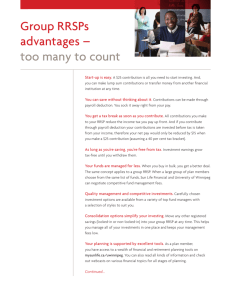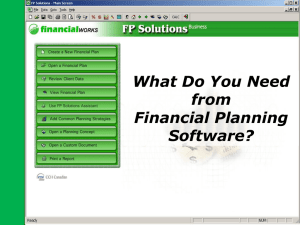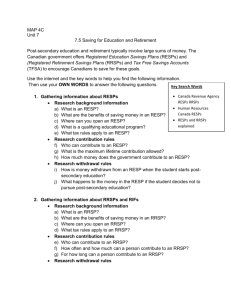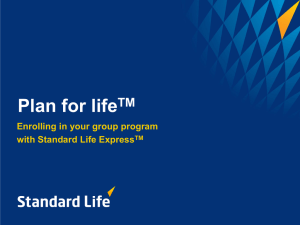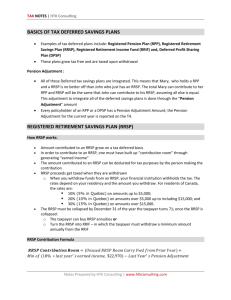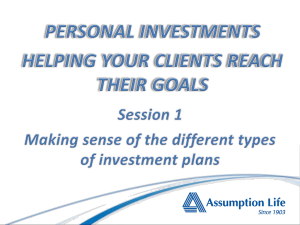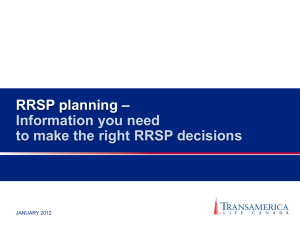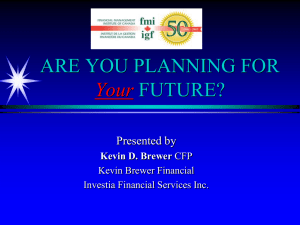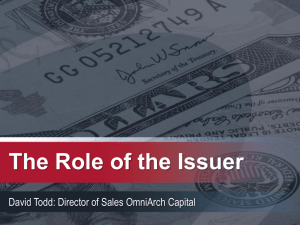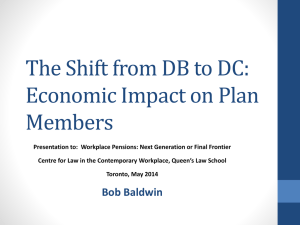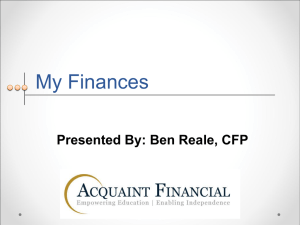An RRSP
advertisement
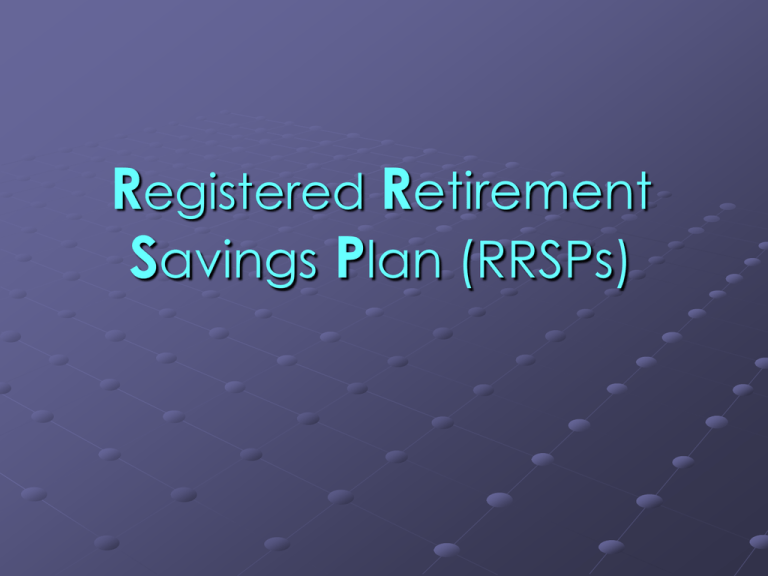
Registered Retirement Savings Plan (RRSPs) What is a RRSP ? An RRSP (Registered Retirement Savings Plan) is a personal savings plan registered with the Canadian federal government allowing you to save for the future on a tax sheltered basis. Types of Investments in your RRSP: o Guaranteed Investment Certificates (GICs) o Treasury Bills (T-Bills) o Mutual Funds o Stocks and Bonds o Equities o Canada Savings Bonds o Mortgage-backed securities o Income Trusts An RRSP is special because… Contributions are tax deductible taxes from income are exempt Tax sheltered Portfolio can grow without being taxed, unless funds are withdrawn Why Consider RRSPs?? RRSP’s can reduce your annual tax bill Add comfort, for individuals who don’t have a company pension plan So all their retirement needs are met Used as a source of financing Ex. purchasing your first home or continuing education Available to individuals who anticipate fluctuations in their income Ex. for maternity leave, career change, employment interruptions Every individual who works, should consider an RRSP …because of the long-term benefits! Benefits of RRSPs: 1. Immediate tax benefits 2. Sheltered from tax 3. at a time when your income is generally highest income earned on your RRSP is not taxed until it is withdrawn By the time you begin to withdraw the funds at retirement, you will probably be in a lower tax bracket than your earning years. Funds withdrawn at that time will benefit from this lower tax rate Reduces the amount you pay in income tax Example of an Immediate Benefit…. Here is an example of an immediate tax benefit, if you invest $5,000 into your RRSP in a year, and your taxable income is $45,000. The tax rate is 26%. $0 RRSP Contribution $5000 RRSP Contribution Taxable Income $45,000 =$45,000-$5,000 =$40,000 Tax $11,700 $10,400 Deferred Tax $0 $1,300 Therefore, you save $1,300 in taxes. Can you take out the money in your RRSP before you retire? Yes, you may. • But, the funds withdrawn from your RRSP will be charged “withholding taxes.” When you take money out of your RRSP, it becomes income and therefore it is taxed. • Government sends an RRSP receipt with the funds withdrawn for the year, on taxable income. Funds will not be taxed, unless the following occurs.... Lifelong Learning Plan (LLP) Can withdraw up to $10,000 tax free a year, to help pay for yourself or spouse to continue education. Must repay at least 10% per year for up to ten years Generally, your repayments start 5 years after your first withdrawal. First Time Home Buyers' Plan (HBP) •Ability to withdraw up to $25,000 from your RRSP, to buy or build qualifying home for yourself •If purchasing house with a spouse, both can take up to $25,000 in their accounts. •Must be repaid within 15 years. In the Event of Death… Proceeds of the RRSP goes to beneficiary, or to the estate if no beneficiary was designated Beneficiary is identified on the RRSP, or the RRSP holder’s will Event of Death: RRSP will remain tax-sheltered if… Surviving spouse is the beneficiary Proceeds are transferred to an RRSP under his/her name No surviving spouse, but have children or grandchildren, named as the beneficiary Children or grandchildren, regardless of age, are financially dependent because of physical or mental disability Types of RRSPs: 1) A Basic RRSP For individuals who want a simple savings account, under their own name Available at the bank/financial institutions Offers a smaller range of investment choices Some advice from staff May/may not have to pay investment costs, commission fees Types of RRSPs: 2) A self-directed RRSP For individuals who feel they know enough to choose their own investments Available at brokerage firms Offers wider range of investment choices, without advice Have to pay cost for plans and investment costs Types of RRSPs: 3) A group RRSP at work Available at workplace Each individual has their own RRSP, but it is managed by the same insurance, bank or mutual co. Offers a wide range of investment choices Funds deposited directly after pay cheques Employer can add money to group RRSP Employer pays cost of plan, you must pay investment costs Types of RRSPs: 4) A Spousal RRSP Available for qualified individuals: who are married, lived together for more than 12 months, have a child together by birth/adoption Contribute their money into spouse’s RRSP Balancing their income, and reduces tax at retirement Who may NOT contribute into an RRSP? Individuals in a lower tax bracket Such as children and young workers Is the money in your RRSP Safe? No, just because money is held in your RRSP, investors should not assume their funds are safe. Why are they not necessarily safe? Ability to lose money depending on type of investments chosen Example: Stocks. Value of RRSP portfolio can fluctuate day to day Carry Forward When an RRSP investor can not make the maximum contribution one year, so it is brought forward to the next couple of years An individual may choose to delay claiming their current year's RRSP tax deduction. To take the deduction in a later year, you must make sure that your allowable deduction limit has not been reached. COSTS $$$ to set up an RRSP... Will vary depending on types on investments: A fee to open your RRSP account A fee to manage/hold your RRSP account A fee to manage the mutual funds in your plan A fee to set up a self-directed RRSP A fee when you buy/sell stock in a self-directed RRSP More Information on RRSPs.... You can contribute to your RRSP until December 31st on the year you turn 71. When you reach 71, you can then: cash in your RRSP transfer the investments in your RRSP to a Registered Retirement Income Fund, or Registered Annuity, from which you must begin drawing retirement income. Remember, it is beneficial to invest in RRSPs, as soon as possible. It lets you save for your future, while helping you save tax money.
